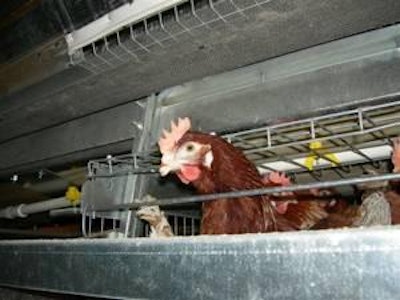
An analysis of egg production systems in 35 countries (chart) reveals that the move away from conventional cages to bird-friendly units (often called enriched cages), barns and free-range systems is mainly occurring in Europe. Conventional cage systems still account for virtually all commercial egg production in other markets.
However, change is not restricted to Europe alone. As a result of Californian voters overwhelmingly passing Proposition 2 on the day of the US presidential election, California may become the first US state to ban cages for layers. If the Californian result is anything to go by, other states may follow suit.
Proposition 2 requires that laying hens should be provided with sufficient space to lie down, stand up, fully extend their limbs and turn around freely. However, following last November's vote, regulations still have to be drawn up detailing what the law, which will come into force in 2015, actually means.
Proposition 2 is viewed as a disaster for egg producers in what is the US' fifth-largest egg laying state, home to some 20 million birds. While some producers there may switch to free range, many say that they will consider moving their operations to other states or even across the border to Mexico.
Proposition 2 will not ban the sale of conventionally produced eggs in California, which sources about a third of its eggs from other states. The Humane Society of the United States (HSUS) and the California Veterinary Medical Association introduced the measure, with each side raising some $8.5 million.
However, International Egg Commission (IEC) data reveals that, with the exception of Switzerland and Norway, the only countries noticeably exhibiting a marked swing away from conventional cages to less-intensive systems are those that are members of the European Union and this is in response to the EU directive banning conventional cages from 2012.
While some of the data in the table opposite is a "best guess," it nevertheless provides a useful guide to the situation. It should also be remembered that, in some instances, the proportion of birds kept in cages could include the more acceptable "bird-friendly" cage units along with conventional cages.
In many countries, particularly in the Far East, Middle East and South America, virtually all of the commercial laying flock is housed in conventional cages.
Missed deadlines
While most of the EU member states are making efforts to gradually switch production to less-intensive cages, and to barn and free-range systems, some, and in particular Spain and Italy, still have a high proportion of their flocks in conventional cages, with no hope of achieving the zero percent in cages demanded by the EU by 2012. Even in the UK, where only some 62% of the flock is in cages, it is forecast that 40% of birds will still be cage-reared in 2012. But in Austria, all layers have been housed in non-cage systems from January.
In Oceania, Australia and New Zealand are implementing new animal welfare rules. In Australia, while some 85% of consumers buy free-range eggs, about 90% of the eggs consumed come from cages. The actual level of free-range output in Australia is slowly rising but stands at only some 16-18%.
Eggs from non-conventional cages cost less than those produced in other management systems.
Peter van Horne, the IEC's economic analyst, says that when compared with conventional cages, the EU's enriched cages would add 8% to the cost of output while eggs from a less-intensive cage system would be 10% dearer. For deep litter or barn eggs, the cost rise was of 21%, while free range and organic eggs would be costlier.
Many consumers, however, are looking for the cheapest eggs possible amid the global crisis and this has hurt sales of more expensive eggs. Thus, the future of conventional cages, from today's viewpoint, looks reasonably secure.


















